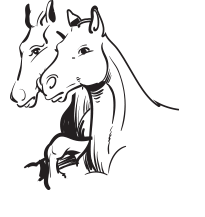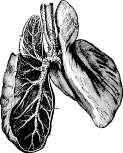What is
Equine HerpesVirus?
Equine HerpesVirus (EHV), also known as “rhinopneumonitis” (or “rhino”), is a common virus found in many horses worldwide. There are nine identified viruses within the EHV family. The two most pertinent to domestic equine populations are EHV-1 and EHV-4.
Time between the infection and the appearance of symptoms can be as short as 24 hours but usually takes 4–6 days (or longer).
Both EHV-1 and EHV-4 cause respiratory disease.
Neurological disease is typically associated with EHV-1 but rarely with EHV-4.
Abortions are typically associated with EHV-1 but rarely with EHV-4.
EHV can affect all horses, regardless of age, breed, or sex, though the clinical signs may vary.
Horses can be infected with and transmit EHV without showing any signs or symptoms.
How is Equine
Herpes Virus contracted?

EHV can be transmitted both directly and indirectly from infected to uninfected horses. The virus can survive for up to seven days in the environment under normal conditions, but as long as one month under ideal conditions.
The most common mode of transmission of EHV is through direct contact between horses. Infected horses typically shed the virus in their respiratory secretions for a week to 10 days, or longer, following initial infection. Mares who have aborted also shed the virus via the respiratory route, as well as through highly infectious fetal tissues and fluids.
Horses can also contract EHV indirectly. Nasal secretions from infected horses can contaminate objects such as grooming equipment, tack, trailers, and feed and water buckets. People can also transmit the disease between horses via contaminated hands or clothing.
Clinical signs and symptoms of Equine HerpesVirus
Clinical signs and symptoms of respiratory disease associated with EHV include:
Fever in two phases,
peaking once on days 1–2 and again on days 6–7
Discharge from the eyes and nose,
with minimal coughing
Enlarged lymph nodes
The neurological disease associated with EHV is also known as “Equine HerpesVirus Myeloencephalopathy” (EHM). EHM is usually sudden-onset and rapidly progressing.
Clinical signs and symptoms may include:
Nasal discharge,
but otherwise minimal respiratory symptoms
Fever,
which is typically one of the first signs of EHV; an unexplained fever should raise a flag
Hind limb weakness
"dog-sitting," leaning, and/or inability to stand
Incoordination and stumbling,
(mild effects of the disease)
Urinary incontinence
Head tilt
Loss of tail tone
Prevention and treatment
of Equine HerpesVirus

THE PROGNOSIS OF HORSES INFECTED WITH EHV VARIES:
In typical cases, the outcome is usually favourable, with recovery in a matter of weeks.
In cases of more advanced neurological disease, however, such as with horses who are unable to urinate or stand, the prognosis is poor.
Treatment for horses infected with EHV is a combination of supportive care and symptom management. Fever, pain, and inflammation are often treated with non-steroidal anti-inflammatories, and some horses may require IV fluids. Antiviral drugs may be used to decrease the risk of developing EHM in horses infected with or exposed to EHV.
Preventative measures can be taken to reduce the risk of EHV transmission and outbreak. These include:
Vaccination
Vaccines are available to help prevent respiratory disease and abortions associated with EHV and reduce viremia (the presence of the virus in the blood). Since EHV is a risk-based vaccine, talk to your veterinarian to help decide if your horse is at risk.
Biosecurity
Public facilities such as boarding stables or showgrounds can help minimize the likelihood of an EHV outbreak by implementing and following a biosecurity protocol. Biosecurity protocols vary with each specific situation, while aiming to reduce the chance of an infectious disease being brought into a facility, either by animals, people, or equipment.
 Learn more about how
Learn more about how
VETERA® and CALVENZA® vaccines can help protect your horse from EHV.
Find out how